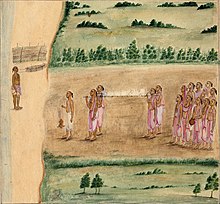
Antyesti (IAST: Antyeṣṭi, Sanskrit: अन्त्येष्टि), also known as Antima Samskara, Antya-kriya, Anvarohanyya, or as Vahni Samskara,[2] literally means "last sacrifice" or "final auspicious ceremony", and refers to the funeral rites for the dead in Hinduism, which usually involves cremation of the body. This rite of passage is the last samskara in a series of traditional life cycle samskaras that start from conception in Hindu tradition.[3][4]
The details of the Antyesti ceremony depend on the region, social group, gender and age of the dead.[5][6][7]
- ^ Museum record 2007,3005.2 The British Museum, London
- ^ Antayesti Cologne Sanskrit Digital Lexicon, Germany
- ^ Pandey, R.B. (1962, reprint 2003). The Hindu Sacraments (Saṁskāra) in S. Radhakrishnan (ed.) The Cultural Heritage of India, Vol.II, Kolkata:The Ramakrishna Mission Institute of Culture, ISBN 81-85843-03-1, p.411 to 413
- ^ Ph.D, Victoria Williams (2016-11-21). Celebrating Life Customs around the World: From Baby Showers to Funerals [3 volumes]. ABC-CLIO. p. 118. ISBN 9781440836596.
- ^ Rajbali Pandey (2013), Hindu Saṁskāras: Socio-religious Study of the Hindu Sacraments, 2nd Edition, Motilal Banarsidass, ISBN 978-8120803961, pp. 234-245
- ^ Cite error: The named reference
olsonantwas invoked but never defined (see the help page). - ^ J Fowler (1996), Hinduism: Beliefs and Practices, Sussex Academic Press, ISBN 978-1898723608, pp. 59-60